The Humble recipe of Methi Ki Subji made with potatoes, green chilies, fresh and aromatic methi leaves (fenugreek leaves) is a delight in winters. A cold afternoon that has a simple meal of Aloo Methi teamed with Paratha or Chapati is all we wish for on a weekend!
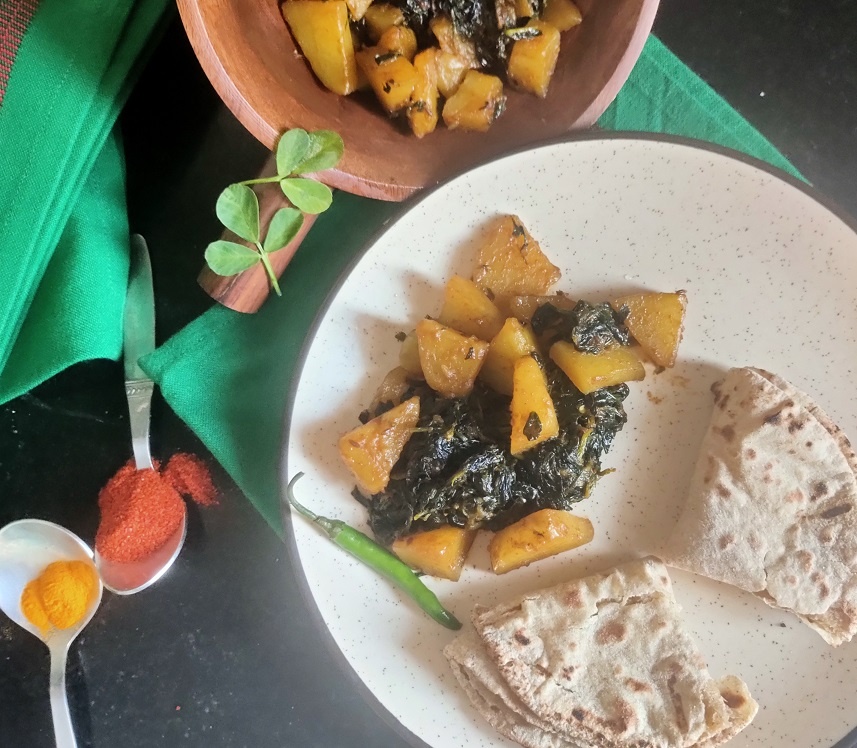
Every generation that I have known in my family, there is always someone who is a huge fan of potatoes. Indian winters are dull without the aroma of fresh Methi leaves. In a large family setup, ladies of the house sit together and sort the green leaves of Methi, Saag, Palak and Bathua and keep them wrapped separately in a dry newspaper to use in the upcoming week.
Aloo Methi Subji, made using aloo and fresh methi leaves (also called fenugreek), is a flavorful side Indian dish that is rich in fiber and iron. A simple heeng Jeera tempering is made to aloo methi along with easily available spices like haldi and red chilli powder.
An amazing observation made here is that the time to sort leaves is much more than cooking it. The time is totally worth it.
If you love winter greens, you might also check the popular recipes from the blog: Bathua Paratha, Palak Paneer, Bathua Raita.
Jump to:
Why Would You Love This Recipe?
- Super Easy Ingredients
- A quick recipe that gathers in no time, if you already have sorted leaves.
- Vegan and Gluten Free.
- Weight-Loss Friendly.
- Healthy Side Dish.
- Can be made Kids Friendly.
- The Best Methi Aloo Subji Ever!
Ingredients
- Methi Leaves- The star ingredient of this recipe are Methi leaves. These green leafy beauties are largely available in winters in India. Make sure to sort them a day in advance to speed up your cooking process. They are good when kept dry in a newspaper for about 3-4 days. I have used the local produce to support our farmers. If you don't have Methi leaves available in your area, you might try the same recipe with other greens like Kale, celery or watercress leaves. You may use 1:1 substitution.
- Potatoes- The Yukon Gold variety of potatoes work well for this methi recipe. You may use any variety though. Potatoes shall not be very mushy.
- Spices and Salt- Fresh green chili, Turmeric powder, Red Chili powder, Cumin seeds and Heeng powder are the simple spices that I use for tempering aloo methi.
- Mustard Oil- is the heart of Indian vegetables. While we use mustard oil easily in cooking, I understand few countries avoid it for edible purpose. I may suggest using any vegetable cooking oil.
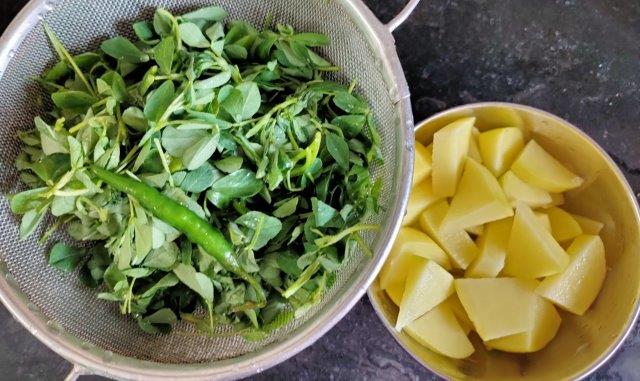
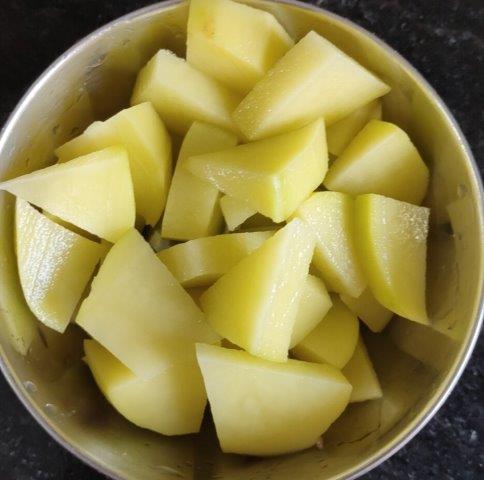
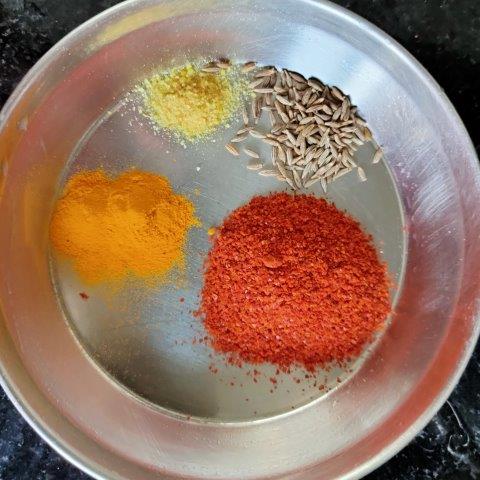
Benefits of Methi Leaves
High in Fiber and low in calories, these nutrition-packed methi leaves help are also rich in Vitamin C, K, A, B2, iron and are hot in nature. That means, they naturally keep body warm and hence we have them in winters.
Methi leaves help in boosting metabolism, maintaining body sugar levels and is great vegetable for diabetic people.
There is a slight bitter taste that's inherent for methi and I don't mind that at all. If you dislike that taste, you may blanch the methi leaves for 5 min and drain the water, before cooking.
Expert Tips
- Sort the leaves a day before. The best way to store methi leaves is to keep dry sorted leaves in a clean newspaper or a dry cloth vegetable bag. They can remain good in refrigerator for 3-4 days in winters.
- You may chop them and wash the day you wish to cook.
- Washing is an important step. You may take a colander and transfer the leaves to it and wash under running water. I prefer to first wash them by soaking it in a large steel vessel (with water) and transfer it to another utensil filled with water and keep changing the water. After 2-3 swaps, the dust will be drained and then I transfer it to colander and wash again.
- I use mustard oil and make this subji in iron vessel. The reason of using iron vessel is that we get the iron for our body right from the vessel. Trust me upon this, the veggies cooked in iron kadai are superb and no worries of it sticking to the bottom of pan.
- Heat mustard oil on full flame till huge vapors appear to burn it. It would take about 1 min for 1-2 tablespoon of oil. Cool it off. Temper only after cooling off till its warm.
- Methi would shrink as it leaves water and would gradually change color to a darker green. You may fry potatoes to have a crispy aloo methi.
FAQs
You may blanch the methi leaves for 5 min before tempering them.
High fiber, Low calorie Aloo Methi subji, which is rich in iron helps you maintain gut health.
Detailed Recipe with Steps
Step 1 Gather, Chop and Wash
Gather the methi leaves. Chop them or use as is. Wash them thoroughly under running water. Take a potato and chop it in not-so thick slices.
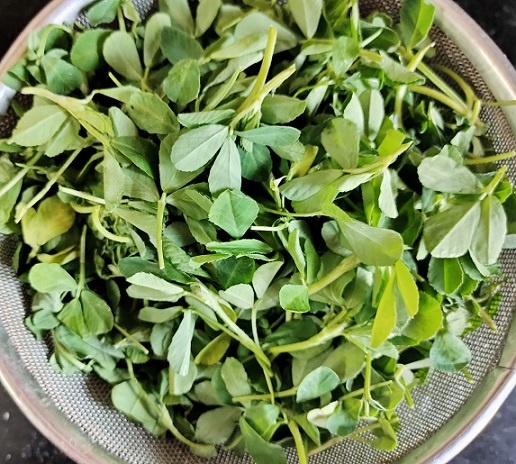


Step 2 Temper
Take an iron kadai and heat mustard oil till it changes its color from dark yellow to almost transparent color. Let it cool down to warm temperature. Don't add anything in hot mustard oil or it might hurt. Add spices and immediately add methi leaves and potato (or else spices might burn). Add green chillies, salt and mix well. Cover it with lid.
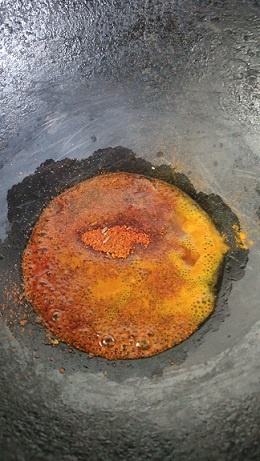
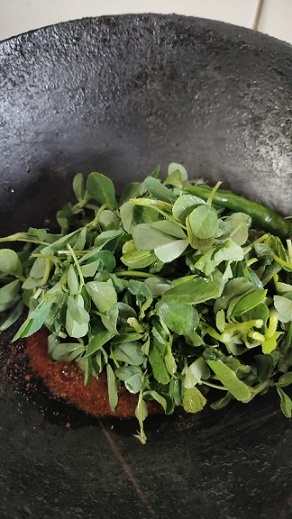
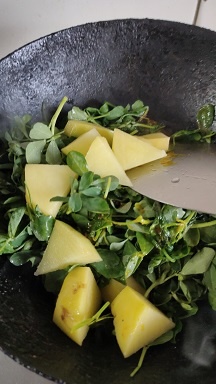
Step 3 Keep Sauteing
Slowly methi would leave water and shrink too. Keep sauteing in between. Once all the water is absorbed and potatoes become soft, the veggie is ready. It takes about 5-10 min. Let it be covered for another 5 min after you switch off the flame.
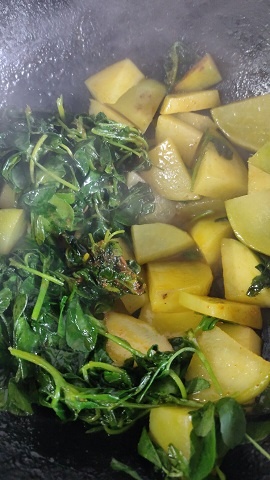
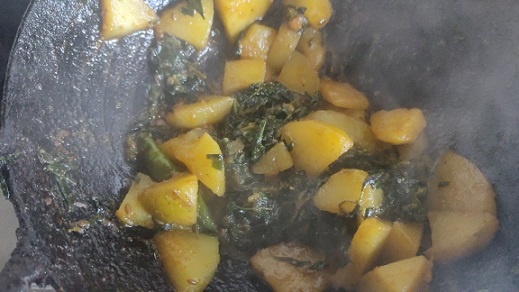
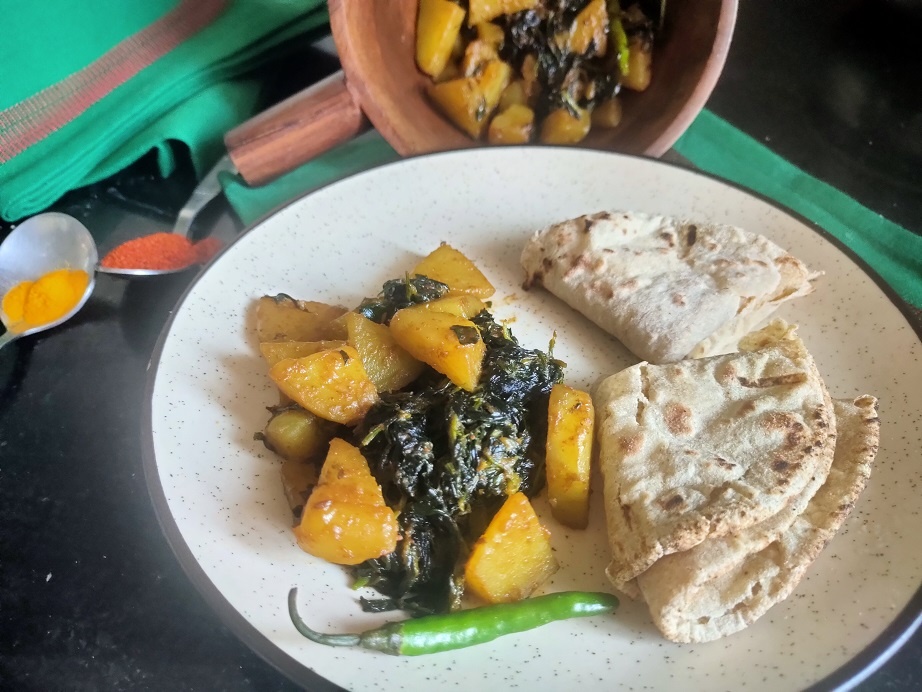
Step 4 Serve It
Aloo Methi subji is ready. Serve it with Paratha or chapati. Enjoy!
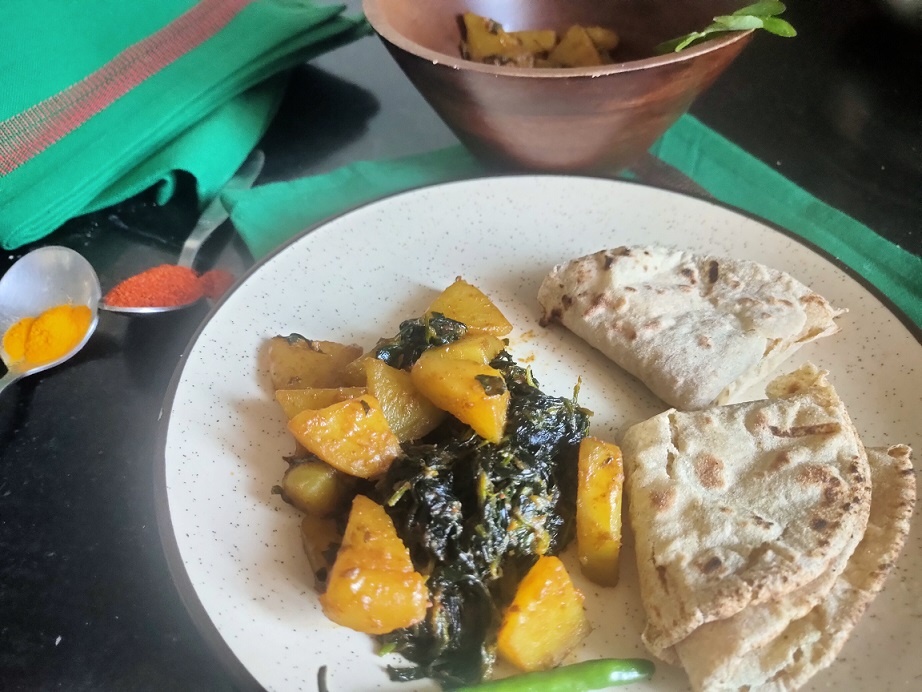
Stories From Kitchen
As a kid, I was not at all a fussy eater. But when it came to leafy vegetables, I would simply not eat. This was true even when I grew up. My mother-in-law was an amazing cook and her way of cooking really made it easy for me to not just to learn but also eat in a healthy way.
Leafy vegetables usually have a slight bitter taste and they don't have a texture like other veggies (carrots, gobhi) and kids find it tough to adapt to this taste.
Make a wheat Dough using aloo methi subji. Add 1 bowl of subji to around 2 bowls of wheat flour. Add salt, green chilies, red chilly and ajwain. Use water as required. You may also make a wheat dough of raw methi leaves. 1 bowl of washed and sieved methi leaves with 2.5 bowl of wheat flour and salt and spices. Make poori or paratha using above dough and kids would ask more!
You may also like–
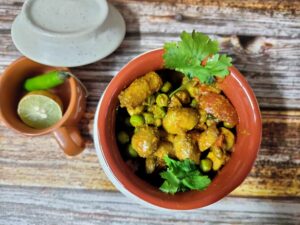
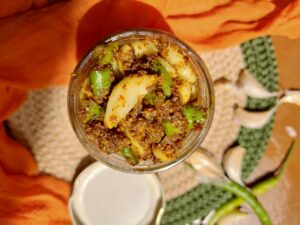
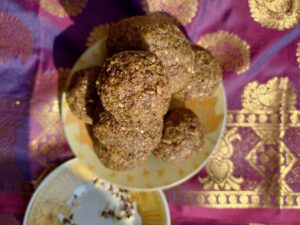
If you make this recipe, share the image of it on our instagram account @veg.buffet or twitter account @vegbuffet
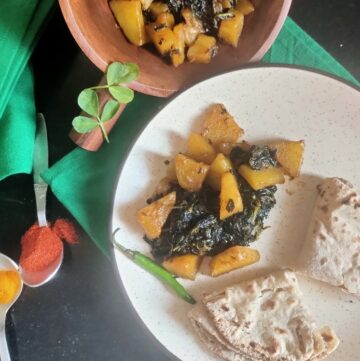
Aloo Methi Subji: A healthy Recipe
Equipment
- Iron Kadai
- Colander
Ingredients
- 250 gm fenugreek leaves (unsorted) methi leaves
- 2 medium potato
- 1 teaspoon haldi
- 1.5 teaspoon red chilli can adjust
- ½ teaspoon Heeng
- 1 small green chilli optional
- 1 tablespoon mustard oil
- salt as per taste
- 1 teaspoon amchur optional
Instructions
- Gather the methi seeds. Chop them or use as is. Wash them thoroughly under running water. Take a potato and chop it in not-so thick slices.
- Take an iron kadai and heat mustard oil till it changes its color from dark yellow to almost transparent color. Let it cool down to warm temperature. Dont add anything in hot mustard oil or it might hurt.Add spices and immediately add methi leaves and potato (or else spices might burn). Add green chillies, salt and mix well. Cover it with lid.
- Slowly methi would leave water and shrink too. Keep sauteeing in between. Once all the water is absorbed and potatoes become soft, the veggie is ready. It takes about 5-10 min. Let it be covered for another 5 min after you switch off the flame.
- Aloo Methi subji is ready. Serve it with paratha or chapati. Enjoy!
Notes
- Sort the leaves a day before. The best way to store methi leaves is to keep dry sorted leaves in a clean newspaper or a dry cloth vegetable bag. They can remain good in refrigerator for 3-4 days in winters.
- You may chop them and wash the day you wish to cook.
- Washing is an important step. You may take a colander and transfer the leaves to it and wash under running water. I prefer to first wash them by soaking it in a large steel vessel (with water) and transfer it to another utensil filled with water and keep changing the water. After 2-3 swaps, the dust will be drained and then I transfer it to colander and wash again.
- I use mustard oil and make this subji in iron vessel. The reason of using iron vessel is that we get the iron for our body right from the vessel. Trust me upon this, the veggies cooked in iron kadai are superb and no worries of it sticking to the bottom of pan.
- Heat mustard oil on full flame till huge vapors appear to burn it. It would take about 1 min for 1-2 tablespoon of oil. Cool it off. Temper only after cooling off till its warm.
- Methi would shrink as it leaves water and would gradually change color to a darker green. You may fry potatoes to have a crispy aloo methi.
| Nutrition Facts | |
|---|---|
| Serving size: 1 bowl | |
| Servings: 3 | |
| Amount per serving | |
| Calories | 127 |
| % Daily Value* | |
| Total Fat 1.3g | 2% |
| Saturated Fat 0.1g | 1% |
| Cholesterol 0mg | 0% |
| Sodium 10mg | 0% |
| Total Carbohydrate 24.3g | 9% |
| Dietary Fiber 3.3g | 12% |
| Total Sugars 1.1g | |
| Protein 5g | |
| Vitamin D 0mcg | 0% |
| Calcium 276mg | 21% |
| Iron 2mg | 12% |
| Potassium 496mg | 11% |
| *The % Daily Value (DV) tells you how much a nutrient in a food serving contributes to a daily diet. 2,000 calorie a day is used for general nutrition advice. | |

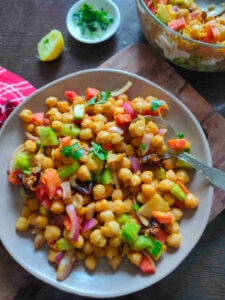
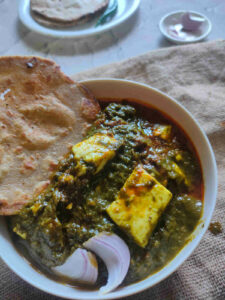
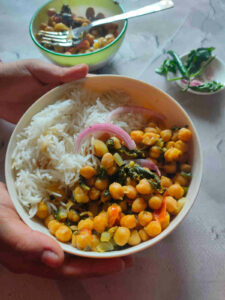
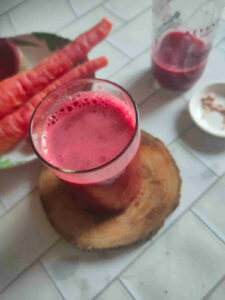
Share your Views